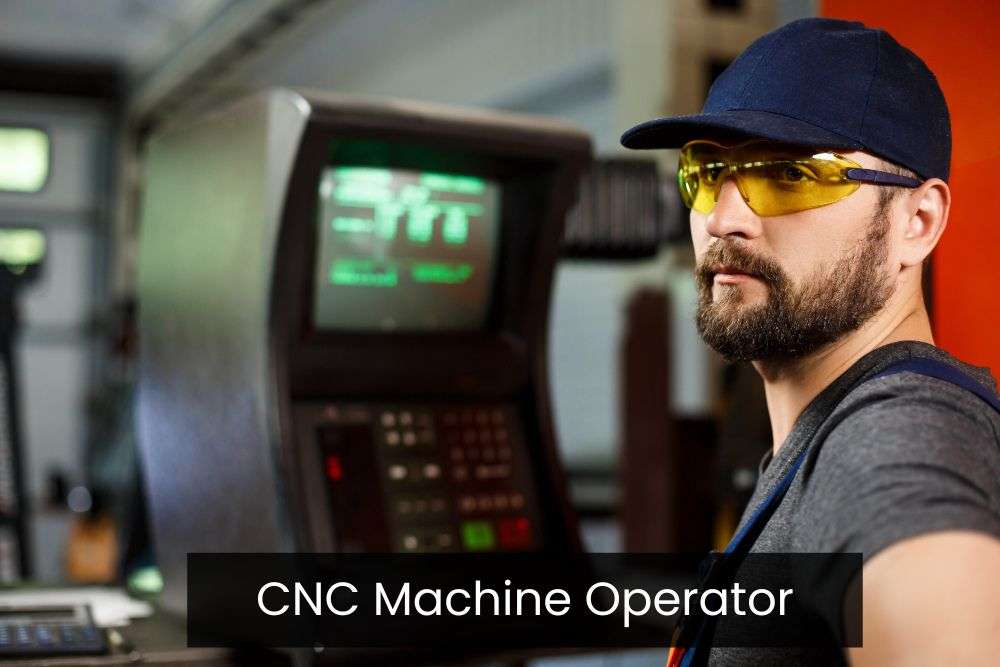In the world of manufacturing and production, the backbone of precision and efficiency lies in the hands of skilled CNC machine operators. These professionals play a pivotal role in shaping the landscape of modern industries, where technology intertwines with craftsmanship. Let’s delve into the key facets that underscore the significance of hiring a proficient CNC machine operator.
| Key Takeaways |
|---|
| 1. Structured onboarding ensures a smooth transition for CNC operators. |
| 2. Comprehensive training is key for efficient machine operation. |
| 3. Team integration, mentorship, and activities foster a positive workplace culture. |
| 4. Negotiate salary with market research, transparency, and diverse benefits. |
| 5. Job descriptions must be clear, detailed, and reflect company culture and values. |
1 Understanding the Job Requirements
Hiring a competent CNC machine operator goes beyond a cursory glance at a resume. It’s about identifying an individual with a multifaceted skill set that seamlessly blends technical expertise and interpersonal skills. Let’s break down the essential job requirements into two key categories: technical skills and soft skills.
Hire a CNC Machine Operator
Call us at 087 738 8306 or Fill the form below and we will get back to you ASAP.
A. Technical Skills
1. Proficiency in Operating CNC Machines
At the core of a CNC machine operator’s skill set lies the ability to navigate the intricacies of CNC machines with finesse. This goes beyond basic operational knowledge; it involves an intuitive understanding of machine controls, tooling setups, and the intricacies of various machining processes. A skilled operator should be adept at interpreting blueprints, setting up machines, and executing precision operations with efficiency.
Real-Life Example: Imagine a scenario where a CNC machine encounters a deviation in material alignment. A proficient operator not only identifies the issue swiftly but adjusts the machine settings on the fly, ensuring minimal disruption to the production schedule.
2. Knowledge of Programming and Troubleshooting
CNC machines are not mere mechanical tools; they are guided by intricate lines of code that determine each movement and operation. A skilled CNC machine operator possesses a deep understanding of programming languages specific to CNC, enabling them to create, modify, and troubleshoot programs. This proficiency extends to diagnosing and rectifying issues that may arise during the machining process.
Real-Life Example: In a fast-paced manufacturing environment, a CNC machine suddenly starts producing components with deviations. A competent operator, armed with programming prowess, swiftly identifies and rectifies the error in the code, ensuring that the production line remains uninterrupted.
3. Familiarity with Different Materials and Tools
Versatility is the hallmark of a skilled CNC machine operator. From metals to plastics, each material demands a nuanced approach. The ability to select the right tools, understand material properties, and adjust machining parameters accordingly is crucial. This includes knowledge of cutting speeds, feed rates, and toolpath strategies tailored to the specific material being processed.
Real-Life Example: Consider a manufacturing facility where a CNC machine is tasked with producing components from different materials, each with its unique characteristics. A proficient operator seamlessly transitions between setups, optimizing tooling and parameters for each material, ensuring precision across diverse production requirements.
B. Soft Skills and Attributes: Beyond the Machine
1. Attention to Detail
In the world of CNC machining, precision is paramount. A skilled operator possesses an unwavering attention to detail, scrutinizing every dimension and contour to ensure the final product meets exact specifications. This meticulousness extends from the initial blueprint review to the final inspection of machined components.
Real-Life Example: Picture a CNC machine tasked with creating intricate components for a medical device. A detail-oriented operator meticulously inspects each dimension, ensuring that the final product aligns with the stringent quality standards required in the healthcare industry.
2. Problem-Solving Abilities
CNC machining is not without its challenges. From tool wear to unexpected machine deviations, a skilled operator acts as a problem-solving maestro. They possess the ability to diagnose issues, implement corrective measures, and optimize processes to overcome obstacles, ensuring continuous and efficient production.
Real-Life Example: In the midst of a high-volume production run, a CNC machine encounters an unexpected tool malfunction. A resourceful operator swiftly troubleshoots the issue, replaces the tool, and recalibrates the machine, preventing costly downtime.
3. Ability to Work in a Team
While CNC machine operators often work independently, they are integral parts of a larger manufacturing team. The ability to communicate effectively, collaborate with colleagues, and contribute to a cohesive working environment is crucial. This includes sharing insights, providing feedback, and actively participating in continuous improvement initiatives.
Real-Life Example: In a manufacturing facility, a CNC machine operator collaborates with colleagues from quality control and engineering to enhance the efficiency of a specific machining process. Their ability to communicate ideas and work collaboratively results in streamlined operations and improved overall productivity.
2 Screening and Shortlisting Candidates
In the relentless pursuit of identifying the perfect CNC machine operator, a strategic screening process is the linchpin. Screening goes beyond the resume; it’s about delving into the candidate’s technical prowess and assessing their compatibility with your company’s culture. Let’s explore the crucial steps in screening and shortlisting candidates.
A. Importance of a Structured Screening Process
In the dynamic world of talent acquisition, a structured screening process is not just a formality; it’s a strategic imperative. It serves as the initial filter, ensuring that only candidates with the right blend of technical skills and cultural fit progress to the next stage of the hiring journey.
Key Elements of a Structured Screening Process:
- Resume Review: Scrutinize resumes to identify candidates with relevant experience and qualifications.
- Technical Proficiency Assessment: Utilize pre-employment assessments or tests to gauge the candidate’s technical prowess in CNC machining.
- Initial Communication: Conduct a preliminary communication round to assess communication skills and convey the company’s values.
B. Initial Interview Tips to Assess Technical Skills
The initial interview is the gateway to understanding the candidate’s technical acumen. It’s a dynamic exchange where questions are not just about what’s on the resume but about how the candidate’s skills align with the intricacies of your CNC machine operator requirements.
Tips for Assessing Technical Skills:
- Case-Based Questions: Pose real-world scenarios to assess the candidate’s problem-solving abilities in a CNC machining context.
- Programming Proficiency: Delve into the candidate’s programming skills, asking about their experience with specific CNC programming languages.
- Machine Operation Scenarios: Present hypothetical machine operation challenges and evaluate the candidate’s approach to troubleshooting.
C. Methods for Evaluating Soft Skills and Cultural Fit
While technical skills are the bedrock, soft skills and cultural fit are the adhesive that binds a team together. Assessing a candidate’s ability to collaborate, communicate, and adapt to your company’s culture is paramount.
Strategies for Evaluating Soft Skills:
- Behavioral Questions: Pose questions that delve into the candidate’s past experiences, highlighting instances where soft skills were crucial.
- Teamwork Scenarios: Assess how the candidate envisions collaboration within a team and their approach to resolving conflicts.
- Cultural Fit Assessment: Gauge the candidate’s alignment with your company’s values and cultural nuances.
3 Conducting Effective Interviews
The interview stage is where the intricacies of a candidate’s expertise and personality come to the forefront. Crafting a set of targeted questions ensures a comprehensive evaluation, separating the proficient CNC machine operators from the rest. Let’s explore the key elements of conducting effective interviews.

A. Role-Specific Questions to Gauge Expertise
1. Example: “Can you explain a complex CNC programming task you’ve handled?”
This question delves into the candidate’s ability to articulate their experience with precision. It goes beyond a mere listing of tasks on a resume, requiring the candidate to narrate a specific scenario where their programming prowess was put to the test. This not only assesses technical knowledge but also the candidate’s communication skills.
Real-Life Scenario: Imagine a candidate describing a scenario where they were tasked with programming a CNC machine for a highly intricate aerospace component. Their ability to navigate the complexities of the task, address challenges, and achieve precision in the final product provides valuable insights into their expertise.
Hire a CNC Machine Operator
Call us at 087 738 8306 or Fill the form below and we will get back to you ASAP.
4 Practical Assessment and Testing
While interviews offer a window into a candidate’s capabilities, practical assessments provide a tangible demonstration of their skills. Incorporating hands-on testing ensures that the candidate can translate their knowledge into action. Let’s explore the nuances of practical assessments for CNC machine operators.
A. Incorporating Hands-On Assessments into the Hiring Process
The tactile nature of CNC machining demands a hands-on approach to assessment. Integrating practical assessments into the hiring process not only validates a candidate’s technical proficiency but also reveals their ability to apply theoretical knowledge in a real-world setting.
Key Considerations for Hands-On Assessments:
- Simulated CNC Programming: Create a scenario where candidates are given a blueprint and tasked with programming a CNC machine to produce a specific component. This assesses their ability to translate design into executable code.
- Tooling and Material Handling: Evaluate a candidate’s familiarity with different materials and tools by presenting them with a range of materials and asking them to select appropriate tooling for a given machining task.
B. Examples of Practical Tasks for CNC Machine Operators
1. Setting Up a CNC Machine
Task Description:
Candidates are provided with a CNC machine setup scenario, including a blueprint, raw materials, and tooling. They are required to set up the machine, input the necessary programming code, and execute the machining process.
Assessment Criteria:
- Proficiency in machine setup procedures.
- Accuracy in translating a blueprint into CNC programming.
- Efficient utilization of tooling and materials.
2. Identifying and Resolving Common Issues
Task Description:
Candidates are presented with a simulated CNC machining scenario where common issues, such as tool wear or material misalignment, occur. They are tasked with diagnosing the issue and implementing corrective measures to ensure the smooth continuation of the machining process.
Assessment Criteria:
- Problem-solving abilities in identifying CNC machine issues.
- Swift and effective resolution of common problems.
- Adherence to safety and quality protocols during issue resolution.
These practical tasks go beyond theoretical knowledge, providing a tangible demonstration of a candidate’s ability to navigate the complexities of CNC machining in a real-world setting.
5 Checking References and Background
The penultimate stage of the hiring journey involves delving into a candidate’s past to glean insights into their professional journey, technical proficiency, and cultural adaptability. Reference checks and background verification serve as the compass, guiding employers to make informed decisions.
A. Importance of Reference Checks
Reference checks are not merely a procedural formality; they are a crucial step in validating the claims and capabilities of a candidate. By reaching out to previous employers and colleagues, employers gain valuable perspectives on the candidate’s work ethic, reliability, and ability to thrive in a team environment.
Key Aspects of Reference Checks:
- Verification of Skills: Confirming the candidate’s technical proficiency and the application of skills in previous roles.
- Work Ethic and Reliability: Gaining insights into the candidate’s work habits, punctuality, and commitment to tasks.
- Team Collaboration: Assessing how well the candidate collaborates with team members and adapts to the dynamics of a workplace.
B. Verifying Work History and Technical Proficiency
Work History Verification:
- Roles and Responsibilities: Confirming the accuracy of the candidate’s listed roles and responsibilities in previous positions.
- Reasons for Departure: Understanding the circumstances behind the candidate’s departure from previous roles.
Technical Proficiency Verification:
- Task-Specific Inquiries: Seeking details on the candidate’s experience with specific tasks or projects relevant to the CNC machine operator role.
- Skill Application: Verifying the practical application of technical skills in real-world scenarios.
C. Ensuring a Candidate’s Cultural Fit within the Organization
Cultural fit is the glue that binds a team together, and ensuring that a candidate aligns with the values and dynamics of your organization is paramount. Reference checks provide an opportunity to explore how well a candidate integrates into a company’s cultural tapestry.
Cultural Fit Assessment:
- Team Dynamics: Inquiring about the candidate’s collaboration style and their ability to contribute positively to team dynamics.
- Alignment with Values: Confirming whether the candidate’s personal values align with the company’s mission and culture.
- Adaptability: Assessing the candidate’s adaptability to different work environments and organizational cultures.
6 Negotiating and Closing the Deal
The final act in the hiring symphony involves delicate negotiations and securing the commitment of the chosen candidate. This stage is not just about numbers; it’s about establishing a mutual understanding that sets the stage for a successful and fulfilling professional journey.
A. Strategies for Negotiating Salary and Benefits
Negotiating salary and benefits is a delicate dance that requires finesse and transparency. Employers and candidates both seek a mutually beneficial arrangement that reflects the candidate’s worth and aligns with the company’s budgetary constraints.
Negotiation Strategies:
- Market Research: Conduct thorough market research to ensure that the offered salary and benefits are competitive within the industry.
- Flexible Packages: Consider offering a mix of monetary and non-monetary benefits to cater to the diverse needs and preferences of the candidate.
- Transparent Communication: Foster open communication about the salary negotiation process, setting realistic expectations for both parties.
B. Communicating the Company’s Commitment to Employee Growth
Beyond monetary considerations, candidates are often drawn to organizations that demonstrate a commitment to employee growth and development. Communicating the company’s investment in the professional advancement of its employees enhances the allure of the job offer.
Key Messages for Employee Growth:
- Training and Development Opportunities: Highlight programs or initiatives that support continuous learning and skill enhancement.
- Career Progression Pathways: Outline potential career trajectories within the organization, showcasing a commitment to long-term employee development.
- Mentorship and Support: Emphasize the availability of mentorship programs or support systems that nurture the professional growth of employees.
C. Making the Job Offer and Securing Acceptance
The job offer is the crescendo of the hiring process, and its presentation sets the tone for the candidate’s entry into the organization. The objective is not just to extend an offer but to create an environment where the candidate feels valued and excited to contribute.
Key Elements of Making the Job Offer:
- Clarity and Transparency: Clearly articulate the terms of the offer, including salary, benefits, and any additional considerations.
- Timeline and Expectations: Provide a realistic timeline for the candidate to consider the offer and communicate any expectations or next steps.
- Welcoming Tone: Convey enthusiasm about the prospect of the candidate joining the team, creating a sense of anticipation and belonging.
7 Onboarding and Integration
The hiring journey doesn’t conclude with the acceptance of a job offer; it extends into the crucial phase of onboarding and integration. This stage is the bridge between recruitment and sustained success, laying the foundation for a seamless assimilation of the newly appointed CNC machine operator extraordinaire into the dynamic world of precision manufacturing.
A. Importance of a Structured Onboarding Process
Structured onboarding is more than a routine orientation; it is a strategic investment in acclimating new employees to the organizational culture, processes, and expectations. A well-designed onboarding process not only expedites the adaptation of the new CNC machine operator but also contributes to long-term retention and job satisfaction.
Key Components of Structured Onboarding:
- Introduction to Company Culture: Familiarize the new employee with the company’s values, mission, and workplace dynamics.
- Role-Specific Training: Provide in-depth training on the specific responsibilities of the CNC machine operator role, including machine operation, programming, and quality standards.
- Integration Plan: Outline a clear integration plan that includes interactions with team members, department heads, and key stakeholders.
B. Providing Necessary Training and Resources
Effective onboarding goes hand in hand with comprehensive training. Equipping the new CNC machine operator with the necessary skills and knowledge ensures a swift transition into their responsibilities, minimizing the learning curve and optimizing productivity.
Training and Resource Provision:
- Technical Training: Offer hands-on training sessions to enhance the operator’s proficiency in CNC machine operation and programming.
- Material Familiarization: Introduce the operator to the diverse materials they will be working with, providing insights into the unique characteristics and optimal machining parameters.
- Access to Tools and Software: Ensure that the operator has access to the tools, software, and resources required for efficient job execution.
C. Ensuring a Smooth Integration into the Team and Workplace
The successful integration of a new team member extends beyond technical competence; it involves fostering a sense of belonging and collaboration. Creating an environment where the new CNC machine operator feels valued and integrated into the team contributes to a positive workplace culture.
Strategies for Smooth Integration:
- Team Introductions: Facilitate introductions and interactions with team members, creating a welcoming atmosphere.
- Assigned Mentorship: Designate a mentor to guide the new operator through the intricacies of the workplace, offering support and insights.
- Integration Activities: Organize team-building activities or events that encourage camaraderie and collaboration among team members.
Hire a CNC Machine Operator
Call us at 087 738 8306 or Fill the form below and we will get back to you ASAP.
Conclusion
As the newly appointed CNC machine operator embarks on their role, armed with technical prowess and a commitment to precision, the organization enters a new chapter of innovation and productivity. The collaboration between employer and employee is not just a transaction; it is the forging of a partnership that propels the organization toward greater heights.












